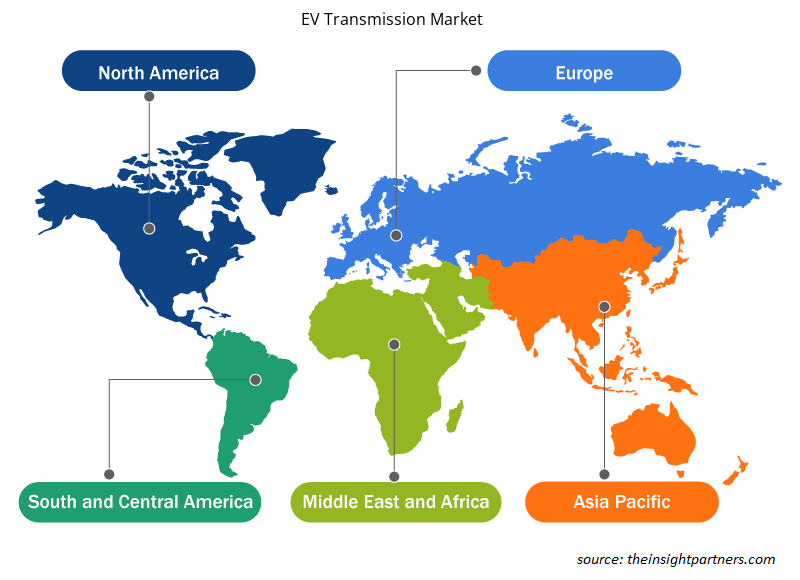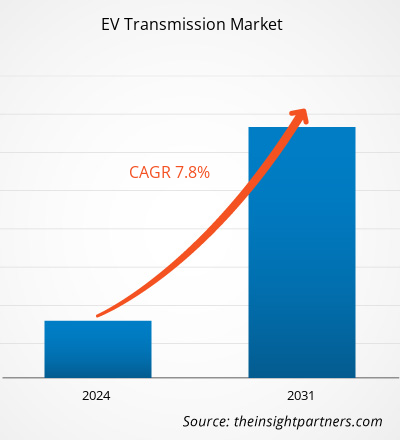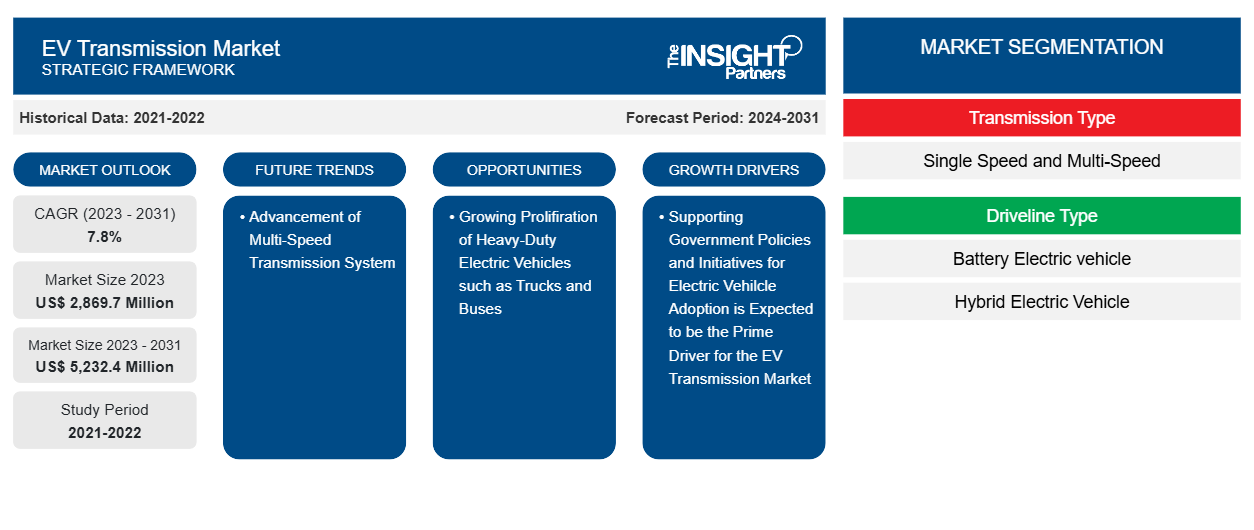Der Markt für EV-Getriebe soll von 2.869,7 Millionen US-Dollar im Jahr 2023 auf 5.232,4 Millionen US-Dollar im Jahr 2031 anwachsen. Der Markt soll in den Jahren 2023–2031 eine durchschnittliche jährliche Wachstumsrate (CAGR) von 7,8 % verzeichnen. Die wachsende Entwicklung in der Elektrofahrzeugbranche wirkt sich weltweit positiv auf die Nachfrage nach EV-Getriebesystemen aus. Der Hauptzweck von EV-Getriebesystemen besteht darin, die Leistungsabgabe von Elektrofahrzeugen zu steuern und die Leistung auf die Räder zu verteilen. Der wachsende technologische Fortschritt in der Fahrzeugbranche wird voraussichtlich das Wachstum des Marktes im Prognosezeitraum vorantreiben.
Marktanalyse für EV-Getriebe
Die steigenden Verkaufszahlen von Elektrofahrzeugen sind auf die zunehmende Konzentration auf Kraftstoffeffizienz und die wachsende Sorge um die Eindämmung der Umweltverschmutzung zurückzuführen. Das wachsende Interesse der Verbraucher an Elektrofahrzeugen dürfte das Wachstum des Marktes für EV-Getriebe auf globaler Ebene vorantreiben. Der Schwerpunkt der Regierung auf die Einführung saubererer Alternativen im täglichen Leben ist ein weiterer wichtiger Faktor, der den Verkauf von Elektrofahrzeugen ankurbelt, was sich positiv auf das Wachstum des Marktes weltweit auswirkt.
Marktübersicht für EV-Getriebe
Der Markt für EV-Getriebe wird nach Typ und Antriebsstrangtyp klassifiziert. Basierend auf dem Typ wird der Markt in Einzelgang- und Mehrganggetriebe unterteilt. Basierend auf dem Antriebsstrangtyp wird der Markt in batteriebetriebene Elektrofahrzeuge (BEV) und Hybridelektrofahrzeuge (HEV) unterteilt. Die wachsende Produktion von Elektrofahrzeugen, da die Nachfrage einen Aufwärtstrend erlebt, wird voraussichtlich den Markt im Prognosezeitraum antreiben.
Passen Sie diesen Bericht Ihren Anforderungen an
Sie erhalten kostenlos individuelle Anpassungen an jedem Bericht, einschließlich Teilen dieses Berichts oder einer Analyse auf Länderebene, eines Excel-Datenpakets sowie tolle Angebote und Rabatte für Start-ups und Universitäten.
-
Holen Sie sich die wichtigsten Markttrends aus diesem Bericht.Dieses KOSTENLOSE Beispiel umfasst eine Datenanalyse von Markttrends bis hin zu Schätzungen und Prognosen.
Regionale Einblicke in den Markt für Elektrofahrzeuggetriebe
Die regionalen Trends und Faktoren, die den Markt für EV-Getriebe im Prognosezeitraum beeinflussen, wurden von den Analysten von Insight Partners ausführlich erläutert. In diesem Abschnitt werden auch die Marktsegmente und die Geografie des EV-Getriebes in Nordamerika, Europa, im asiatisch-pazifischen Raum, im Nahen Osten und Afrika sowie in Süd- und Mittelamerika erörtert.

- Erhalten Sie regionale Daten zum Markt für Elektrofahrzeuggetriebe
Umfang des Marktberichts für EV-Getriebe
| Berichtsattribut | Details |
|---|---|
| Marktgröße im Jahr 2023 | 2.869,7 Millionen US-Dollar |
| Marktgröße bis 2031 | 5.232,4 Millionen US-Dollar |
| Globale CAGR (2023 - 2031) | 7,8 % |
| Historische Daten | 2021-2022 |
| Prognosezeitraum | 2024–2031 |
| Abgedeckte Segmente |
Nach Übertragungstyp
|
| Abgedeckte Regionen und Länder |
Nordamerika
|
| Marktführer und wichtige Unternehmensprofile |
|
Marktteilnehmerdichte: Der Einfluss auf die Geschäftsdynamik
Der Markt für EV-Getriebe wächst rasant, angetrieben durch die steigende Endverbrauchernachfrage aufgrund von Faktoren wie sich entwickelnden Verbraucherpräferenzen, technologischen Fortschritten und einem größeren Bewusstsein für die Vorteile des Produkts. Mit steigender Nachfrage erweitern Unternehmen ihr Angebot, entwickeln Innovationen, um die Bedürfnisse der Verbraucher zu erfüllen, und nutzen neue Trends, was das Marktwachstum weiter ankurbelt.
Die Marktteilnehmerdichte bezieht sich auf die Verteilung von Firmen oder Unternehmen, die in einem bestimmten Markt oder einer bestimmten Branche tätig sind. Sie gibt an, wie viele Wettbewerber (Marktteilnehmer) in einem bestimmten Marktraum im Verhältnis zu seiner Größe oder seinem gesamten Marktwert präsent sind.
Die wichtigsten auf dem Markt für Elektrofahrzeuggetriebe tätigen Unternehmen sind:
- BorgWarner Inc
- Continental AG
- Porsche AG
- Eaton Corporation plc
- Dana Incorporated
- ZF Friedrichshafen AG
Haftungsausschluss : Die oben aufgeführten Unternehmen sind nicht in einer bestimmten Reihenfolge aufgeführt.

- Überblick über die wichtigsten Akteure auf dem Markt für Elektrofahrzeuggetriebe
- Historische Analyse (2 Jahre), Basisjahr, Prognose (7 Jahre) mit CAGR
- PEST- und SWOT-Analyse
- Marktgröße Wert/Volumen – Global, Regional, Land
- Branchen- und Wettbewerbslandschaft
- Excel-Datensatz
Aktuelle Berichte
Erfahrungsberichte
Grund zum Kauf
- Fundierte Entscheidungsfindung
- Marktdynamik verstehen
- Wettbewerbsanalyse
- Kundeneinblicke
- Marktprognosen
- Risikominimierung
- Strategische Planung
- Investitionsbegründung
- Identifizierung neuer Märkte
- Verbesserung von Marketingstrategien
- Steigerung der Betriebseffizienz
- Anpassung an regulatorische Trends























 Kostenlose Probe anfordern für - Markt für EV-Getriebe
Kostenlose Probe anfordern für - Markt für EV-Getriebe